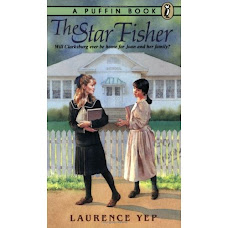BIBLIOGRAPHY
Soto, Gary. 1999. Pacific Crossing. Harcourt Paperbacks; Reprint edition ISBN-10: 0152046968 ISBN-13: 978-0152046965
PLOT SUMMARY
Lincoln Mendoza and his friend Tony live in San Francisco California. Lincoln is studying Kempo, a Japanese martial art. The junior high boys are asked to be foreign exchange students in Japan for the summer. Lincoln will continue his training of Kempo while in Japan. The families in Japan welcome Lincoln and Tony. They have sons the same age as Lincoln and Tony. The boys become close friends with their host families. Mitsuo is a new brother, they plan to be friends forever and visit in San Francisco.
Lincoln and Mitsuo take a trip to Tokyo on the train on a scavenger hunt arranged by Mr.Ono. Mitsuo's father works for the railroad and sends them off in the mail car. In the city the boys find the hidden paper and discover Mr. Ono's joke.
Lincoln and Mitsuo go camping with Mr. Ono. On the trip, a poisonous spider bites Mr.Ono. Lincoln, only fourteen, drives him to the hospital. The car gets a dented fender and a cracked windshield but the adventure is successful and the boys work to repair the car.
CRITICAL ANALYSIS
Soto is familiar with the language of boys today. He uses mannerisms of speech that would be recognizable to young readers. Spanish and Japanese words in the book give a cultural feel to the story. Soto is not repetitive in his translation of the Spanish and Japanese words used throughout the book more than necessary. His choice of words doesn't distract from the story. It gives authenticity to the represented cultures. A glossary follows the story for definitions.
The characters share their love of Mexican food with the Japanese families. The meal that the boys cook is not as successful as the growing friendship. Food is an intigral part of the story and the sharing of cultures.
The length of the book is manageable for young readers. The story moves along quickly with an interesting plot.
On several occasions the boys run from adults and shake their fists in defiance. The actions are extreme and unnecessary for two young boys. Lincoln and Mitsuo would be expected to show a more respectful attitude. It is debatable if the boys' actions are true representations of character.
REVIEW EXCERPT(S)
School Library Journal Grade 6-9-- Mexican-Americans Lincoln and Tony, both 14, are chosen as exchange students for a summer in Japan. They reside with different families and the focus is on Lincoln, with Tony appearing only when a sounding board is needed. The boys prepare a botched Mexican meal for their hosts, and Lincoln saves his host family's father's life by driving, unlicensed, to a hospital. Other than these episodes, little happens in what is essentially a novel of manners contrasting cultural mores. The writing is very good, often elegant, and the point of view is in keeping with a 14-year-old. The text contains many words and phrases in Spanish and Japanese, set off in italics and defined in separate glossaries. Unfortunately, this becomes distracting and often vexing, slowing down an already uneventful narrative. Readers will wonder just what is the lingua franca between the boys and their hosts. All of the Japanese exhibit a complete mastery of English, a nearly universal proficiency that is never explained. Though not without interest, the story is too languid and linguistically confusing to hold the attention of this age group. --John Philbrook, San Francisco Pub. Lib.Copyright 1992 Reed Business Information, Inc.
CONNECTIONS
Other books by Gary Soto
Petty Crimes
Publisher: Harcourt Paperbacks; Reprint edition (May 1, 2006) Language: English ISBN-10: 0152054375 ISBN-13: 978-0152054373 9-12
Taking Sides
Publisher: Harcourt Children's Books; 1 edition (September 15, 1991) Language: English ISBN-10: 0152840761 ISBN-13: 978-0152840761 9-12
Friday, July 6, 2007
Subscribe to:
Post Comments (Atom)







No comments:
Post a Comment